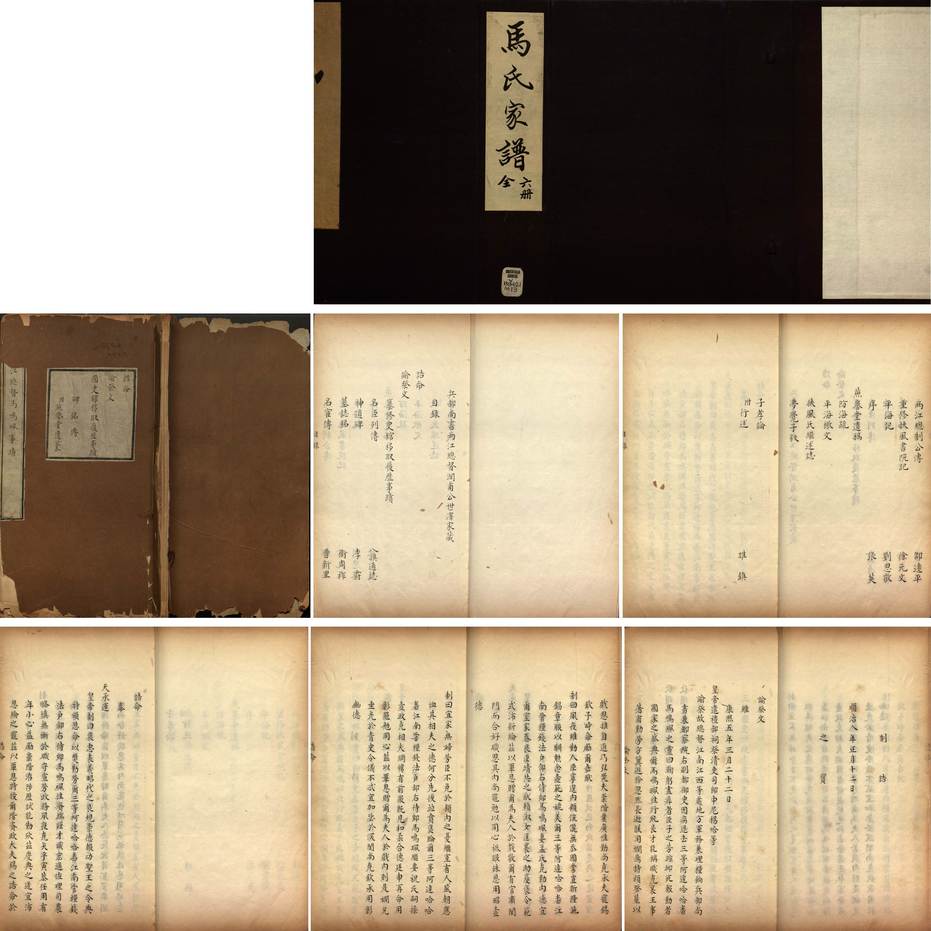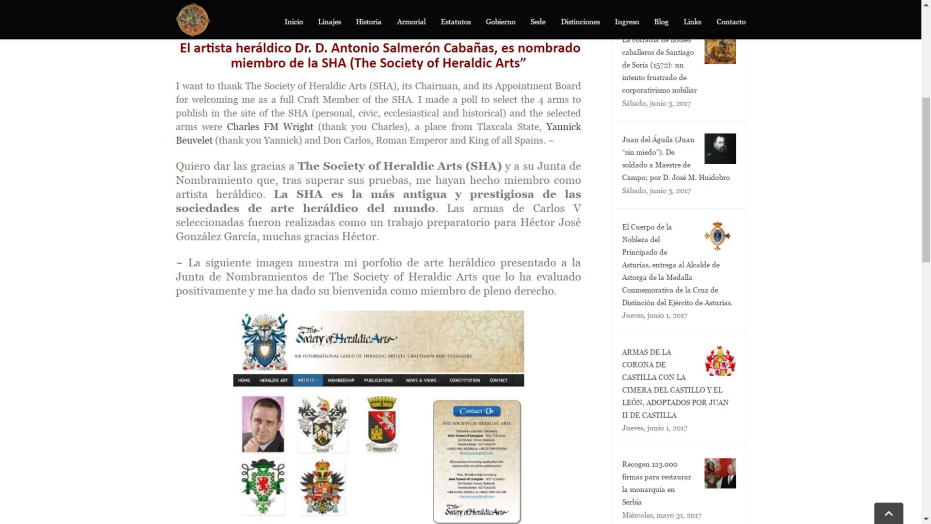
![Ver [Ma, F.; Century XVI] en referencias bibliográficas. Libro abierto, hojas de plata, filo de oro, guardas de gules, tapas de sable.](../css/Libro.Bibliografia.png)
Ma, F.; Century XVI
Anonymous, «Genealogy of the Mǎ Family, 馬民家记», manuscript, from the late Ming to early Qing dynasty, 6 volumes, volume 1, 102 pages, volume 2, 304 pages, volume 3, 242 pages, volume 4, 202 pages, volume 5, 100 pages, and volume 6, 178 pages, total 1128 pages, dated between 1600 and 1735, circa 1735.
Disclaimer
These comments has been writen based on my limited knowledge of Classical Chinese. As such, it may contain inaccuracies or errors. I apologize for any errors and welcome corrections from those more knowledgeable in the subject. It is important to note that, although the manuscript is written in Classical Chinese, some characters in theses comments are in Simplified Chinese.
Cover
-
The title of the work on the cover is
«馬民家记», where:
- «民家记» means Genealogy, and
- «馬» is Mǎ in pīnyīn, it is the family name, literally meaning Horse.
-
The character «馬» is an ideogram, representing a galloping horse:
- the head faces left,
- three horizontal lines to the right of the head represent the mane blowing in the wind,
- the four vertical strokes below represent the legs, and
- the curved stroke at the bottom right symbolizes the tail.
-
Beneath the title on the cover,
we read, from top to bottom and right to left,
as is typical in traditional Chinese:
«六写全» where:
- «六» means six,
- «写» means book, it hasn't plural, books for us, and
- «全» can be translated as complete.
Four generations
The title might suggest it is just the family tree of the Mǎ family, but it is actually a chronicle of the history of a lineage over four generations. Therefore, although it is dated between 1600 and 1735, it is likely written closer to 1735.
The manuscript narrates the deeds and actions of four generations of the Mǎ family from the city of Liáoyáng in northeastern China:
- Great-grandfather: Mǎ Mingpei (1600–1666),
- Grandfather: Mǎ Xiongzhen (1634–1677),
- Father: Mǎ Shiji (1650–1714),
- Son: Mǎ Guozhen (1666–1720).
It seems to be a story of ascent and descent:
- The great-grandfather was a significant figure.
- The grandfather was even more prominent, eventually assassinated, and posthumously awarded titles and an honorary name, «Wenyi».
- The father and son, though important, did not reach the heights of their predecessors.
This manuscript contains official titles, title grants, imperial praises for their actions, historical events, and also the poetic and literary works of the four generations.
Scanned for readability by Westerners
The correspondence between these 6 volumes and the 9 scaned PDF files is as follows:
- Volume 1: PDF 1.
- Volume 2: PDF 2 and PDF 3.
- Volume 3: PDF 4 and PDF 5.
- Volume 4: PDF 6 and PDF 7.
- Volume 5: PDF 8.
- Volume 6: PDF 9.
The Chinese books are read: from back to front, from right to left, and from top to bottom.
The scanning process was done so that what would be the last pages of the book for us, and the first for the Chinese, are at the beginning of the PDF. The pages are scanned in pairs to be readable by Westerners: starting from page 2-1, read from right to left, with 1 blank, and continuing 4-3, 6-5, 8-9... until the end of the PDF file.
The Chinese script used in this manuscript is clear and legible compared to other documents from that era.
Pages
6 volumes:
- volume 1, 51*2 = 102 pages,
- volume 2, 65*2+87*2 = 304 pages,
- volume 3, 66*2+55*2 = 242 pages,
- volume 4, 48*2+53*2 = 202 pages,
- volume 5, 50*2 = 100 pages, and
- volume 6, 89*2 = 178 pages,
Bibliographical reference of century XVI.
Classification: Manuscript, Classical Chinese language and In black and white.
The author is unknown.
External links:
- Library of the Congress.
- Volume 2, initial part.
- Volume 2, final part.
- Volume 3, initial part.
- Volume 3, final part.
- Volume 4, initial part.
- Volume 4, final part.
- Volume 5.
- Volume 6.
Internal resources: MaFamiliaXVIII.01a.tapas.pdf Volume 1 PDF format, MaFamiliaXVIII.02a.tapas.pdf Volume 2, initial part, PDF format, MaFamiliaXVIII.02b.pdf Volume 2, final part, PDF format, MaFamiliaXVIII.03a.tapas.pdf Volume 3, initial part, PDF format, MaFamiliaXVIII.03b.pdf Volume 3, final part, PDF format, MaFamiliaXVIII.04a.tapas.pdf Volume 4, initial part, PDF format, MaFamiliaXVIII.04b.pdf Volume 4, final part, PDF format, MaFamiliaXVIII.05a.tapas.pdf Volume 5 PDF format and MaFamiliaXVIII.06a.tapas.pdf Volume 6 PDF format.
Bibliographical reference of century XVI.
Classification: Manuscript, Classical Chinese language and In black and white.
The author is unknown.
External links:
- Library of the Congress.
- Volume 2, initial part.
- Volume 2, final part.
- Volume 3, initial part.
- Volume 3, final part.
- Volume 4, initial part.
- Volume 4, final part.
- Volume 5.
- Volume 6.
Internal resources: MaFamiliaXVIII.01a.tapas.pdf Volume 1 PDF format, MaFamiliaXVIII.02a.tapas.pdf Volume 2, initial part, PDF format, MaFamiliaXVIII.02b.pdf Volume 2, final part, PDF format, MaFamiliaXVIII.03a.tapas.pdf Volume 3, initial part, PDF format, MaFamiliaXVIII.03b.pdf Volume 3, final part, PDF format, MaFamiliaXVIII.04a.tapas.pdf Volume 4, initial part, PDF format, MaFamiliaXVIII.04b.pdf Volume 4, final part, PDF format, MaFamiliaXVIII.05a.tapas.pdf Volume 5 PDF format and MaFamiliaXVIII.06a.tapas.pdf Volume 6 PDF format.


![Ver [Society of Heraldic Arts in Twelve Lineages] en enlaces recomendados. Áncora de oro y la divisa enlace.](../css/Ancora.Enlace.png)
Society of Heraldic Arts in Twelve Lineages
Publication of my admission to the Society of Heraldic Arts, on the blog Twelve Lineages of Soria in an article entitled: The heraldic artist Dr. Antonio Salmerón Cabañas SHA, is appointed member of The Society of Heraldic Arts. Alongside my photograph are shown examples of gentilic, political, and religious coats of arms.
Categories: Link, Personal, Civic and Religious.
Root: Twelve Lineages of Soria.


Eight-ball
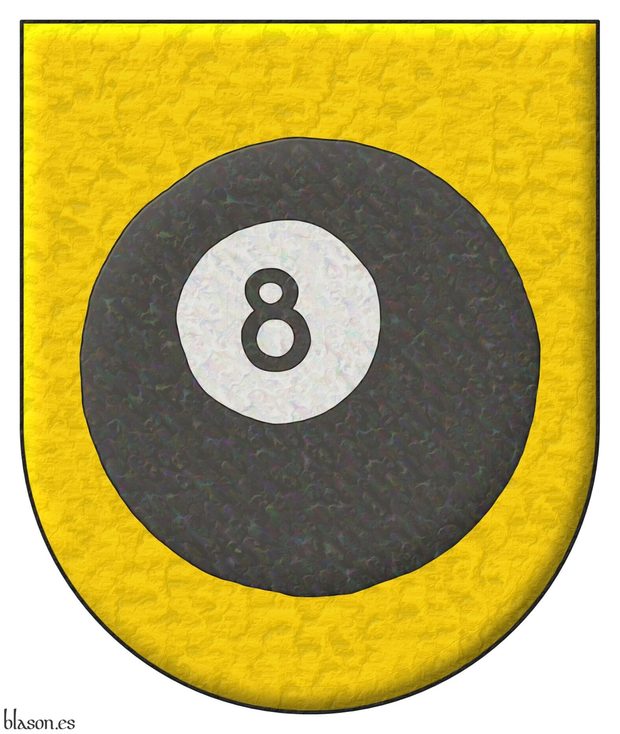
Imaginary coat of arms for the poolgame called Eight-ball.
Or, a Billiard 8 ball proper.
Coat of arms I created with: the shape semicircular at base; the field with a metallic finishing; and the charge with an iridescent finishing.
Blazon keywords: Without divisions, Or, One, Non-classic artifact and Proper.
Style keywords: Semi-circular, Crystalline, Soft metal, Outlined in sable and Illuminated.
Classification: Created, Imaginary and Coat of arms.
Imaginary bearer: Bola 8.


Eight-ball, heraldic poster
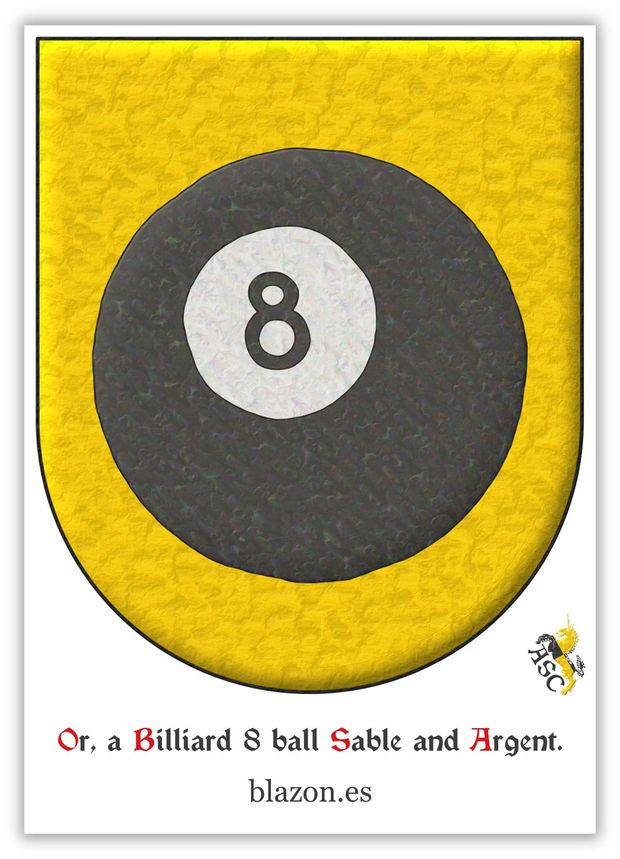
Or, a Billiard 8 ball proper.
Escudo de oro, una bola 8 de billar al natural.
Blazon keywords: Without divisions, Or, One, Non-classic artifact and Proper.
Style keywords: Semi-circular, Crystalline, Soft metal, Outlined in sable and Illuminated.
Classification: Created, Imaginary and Coat of arms.
Imaginary bearer: Bola 8.


![Ver [Eight-ball, another version with a terrace in base] en criterios utilizados. Unicornio saltante sobre la divisa, criterio.](../css/Unicornio.Criterio.png)
Eight-ball, another version with a terrace in base
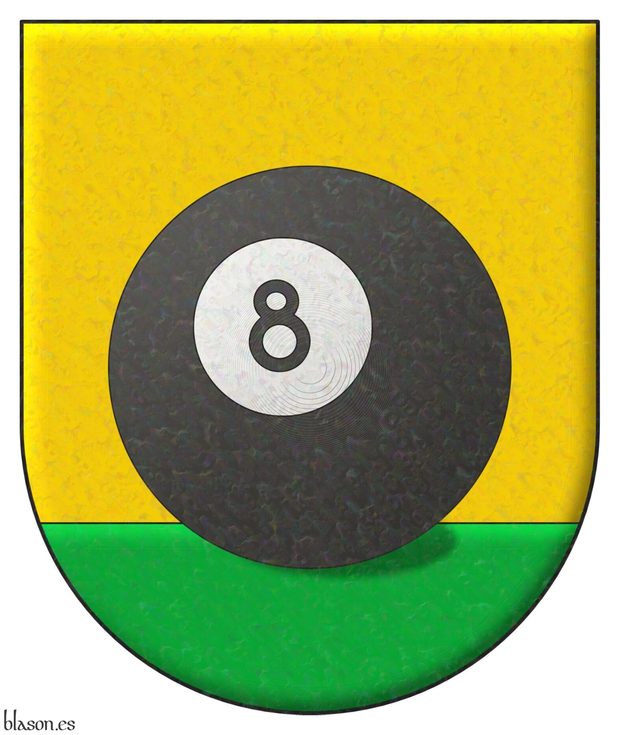
Or, an eight-ball proper on a terrace in base Vert.
Escudo de oro, una bola ocho al natural terrazada de sinople.
Can modern objects appear in a coat of arms?
My rule is: a coat of arms is forever, so any symbol included must be recognizable by future generations. Can you place an iPhone in a coat of arms? No—but not because it’s modern, rather because your grandchildren likely won’t recognize the form of an iPhone; in fact, today’s mobile phones already look quite different from those of a decade ago. Can you include a steam locomotive? Yes, because its form has become anchored in time and in the collective imagination. What about an hourglass, an analog clock, or a black 8-ball from pool? Also yes—their forms are now classics. That is, I believe we can use those symbols that most people already carry in their minds and that are very likely to remain present in the minds of our children and grandchildren. But this is just my humble criterion.
Categories: Criterion, Art, Created, Imaginary, Coat of arms, Semi-circular, Crystalline, Soft metal, Outlined in sable, Illuminated, Without divisions, Or, One, Non-classic artifact, Proper and Terrace in base.
Root: Bola 8.


![Ver [Empresa, conjunto de cargas sobre el campo] en criterios utilizados. Unicornio saltante sobre la divisa, criterio.](../css/Unicornio.Criterio.png)
Empresa, conjunto de cargas sobre el campo
En Don Quijote, [Cervantes Saavedra, M. de; 1605; volumen 1, capítulo 18], el escudo de armas del «duque de Nerbia» se describe utilizando la palabra «empresa»~«enterprise», escribiendo «las armas de los veros azules», refiriéndose al forro de su escudo de armas, «es el poderoso duque de Nerbia, Espartafilardo del Bosque, que trae por empresa en el escudo una esparraguera, con una letra en castellano que dice así: «Rastrea mi suerte»».
Unas líneas antes, y para el joven caballero francés Pierres Papín, con un escudo sencillo de plata sin cargas ni lema, Cervantes escribe sin «empresa»: «que trae las armas como nieve blancas y el escudo blanco y sin empresa alguna».
Cervantes utiliza «empresa» para referirse únicamente a las cargas del escudo de armas, no al campo, ni a su color, metal o forro, ni al lema, lo cual queda claro cuando escribe: «Y desta manera fue nombrando muchos caballeros del uno y del otro escuadrón que él se imaginaba, y a todos les dio sus armas, colores, empresas y motes...».
El término se utiliza con el mismo significado de «carga en el escudo de armas» en el comentario al final de [Febrer, J.; Siglo XIII; trova 39] que dice «y quiso significarle con el puente, que traía por empresa en su escudo», siendo en este caso la carga el puente.
La quinta acepción del término «empresa» en el diccionario [Real Academia Española; 2014] es «Símbolo o figura que alude a lo que se intenta conseguir o denota alguna cualidad de la que se hace alarde, acompañada frecuentemente de un lema», que si bien no se refiere específicamente a la heráldica, está en línea con el uso anterior y deja claro que el lema no es parte de la «empresa» aunque puede acompañarla.
Por tanto, en castellano, el término «empresa» se refiere específicamente a la carga o cargas sobre el campo de un escudo de armas, y no incluye los esmaltes del campo, el lema, ni sus ornamentos exteriores.
Category: Criterion.


![Ver [Enterprise, set of charges on the field] en criterios utilizados. Unicornio saltante sobre la divisa, criterio.](../css/Unicornio.Criterio.png)
Enterprise, set of charges on the field
In Don Quixote, [Cervantes Saavedra, M. de; 1605; volume 1, chapter 18], the coat of arms of the «duke of Nerbia» is described using the word «empresa»~«enterprise», writing «las armas de los veros azules», referring to the fur on his coat of arms, «es el poderoso duque de Nerbia, Espartafilardo del Bosque, que trae por empresa en el escudo una esparraguera, con una letra en castellano que dice así: «Rastrea mi suerte»» ~ «the blue vair arms, is the powerful duke of Nerbia, Espartafilardo del Bosque, who bears as a charge on his shield an asparagus plant, with an inscription in Castilian that says: «Tracks my fate»».
A few lines before, and for the young French knight Pierres Papín, with simple arms Argent without charges or motto, Cervantes writes without «empresa»: «que trae las armas como nieve blancas y el escudo blanco y sin empresa alguna» ~ «who bears arms as white as snow and a shield white and without any charges».
Cervantes uses «empresa» to mean only the charges on the coat of arms, not the field, nor its color, metal or fur, nor the motto, which is clear when he writes: «Y desta manera fue nombrando muchos caballeros del uno y del otro escuadrón que él se imaginaba, y a todos les dio sus armas, colores, empresas y motes...» ~ «And in this way, he went on naming many knights from one and the other squadron that he imagined, and to each of them, he gave arms, colors, charges, and mottos...».
The term is used with the same meaning of «charge on the coar of arms» in the commentary at the end of [Febrer, J.; Siglo XIII; trova 39] which says «y quiso significarle con el puente, que traía por empresa en su escudo» ~ «and wanted to signify with the bridge that he bore as a charge on his shield», where in this case, the charge is the bridge.
The fifth definition of the term «empresa» in the dictionary [Real Academia Española; 2014] is «Símbolo o figura que alude a lo que se intenta conseguir o denota alguna cualidad de la que se hace alarde, acompañada frecuentemente de un lema» ~ «Symbol or figure that alludes to what one intends to achieve or denotes a quality of which one boasts, often accompanied by a motto», which, while not specific to heraldry, aligns with the previous usage and makes it clear that the motto is not part of the «empresa» though it may accompany it.
Then, in Castilian, the term «empresa» refers specifically to the charge or charges on the field of a coat of arms, and it does not include the field tinctures, the motto, or its external ornaments.
Category: Criterion.


![Ver [Gourdon de Genouillac, H.; 1889] en referencias bibliográficas. Libro abierto, hojas de plata, filo de oro, guardas de gules, tapas de sable.](../css/Libro.Bibliografia.png)
Gourdon de Genouillac, H.; 1889
Henri Gourdon de Genouillac, «L'Art Héraldique», part of the series Bibliothèque de l'enseignement des Beaux-arts, published under the direction of M. Jules Comte, Maison Quantin, 290 pages, 21 centimeters, Paris, 1889.
With some black and white small illustrations, it covers the art of heraldry, its history, rules, and applications, and serves as a comprehensive guide for artists, historians, and those interested in the heraldic art.
Contents
- Chapter I. The blazon - Pieces and figures that compose coats of arms, page 11.
- Chapter II. Repertoire of attributes, page 98.
- Chapter III. External ornaments of the shield, their use, and their misuse, page 145.
- Chapter IV. Municipal arms, page 188.
- Chapter V. The blazon in the arts, page 200.
- Chapter VI. Blazoned garments, page 207.
- Chapter VII. Seals, tokens, méreaux of corporations, communities, page 214.
- Chapter VIII. The fleur-de-lis, the eagle, the lion, the leopard, various figures, page 222.
- Chapter IX. The blazon in England, Germany, and other nations, page 230.
- Chapter X. Explanatory glossary, page 252.
- Chapter XI. Heraldic bibliography, page 275.
Bibliographical reference of century XIX.
Classification: French language and In black and white.
The author is Gourdon de Genouillac, Henri.
The following article cites this bibliographic reference:
External resource:
Internal resources: GourdonDeGenouillacH1889.LArtHeraldique.pdf PDF version..

Continue with: Toral y Fernández de Peñaranda, E.; 1970.
-
Language
-
Categories of heraldry
-
Divisions of the field
- Without divisions
- Party per pale
- Party per fess
- Party per bend
- Party per bend sinister
- Tierce
- Tierce sinister
- Tierced per pale
- Tierced per fess
- Tierced per bend
- Tierced pallwise inverted
- Quarterly
- Quarterly per saltire
- Gyronny
- Party per fess, the chief per pale
- Party per pale, the sinister per fess
- Party per fess, the base per pale
- Party per pale, the dexter per fess
- Chapé
- Chaussé
- Embrassé
- Contre-embrassé
- Party per chevron
- Enté
- Enté en point
- Flanched
-
Metals
-
Colours
-
Furs
-
Other tinctures
-
Ordinaries and sub-ordinaries
-
Diminutives of the ordinaries
-
Geometric charges
-
Composite ordinaries
-
Inanimate charges from Nature
Atom, Crescent, Diamond, Emerald, Estoile, Increscent, Lightning flash, Moon, Mount, Mullet, Mullet of four points, Orbital, Plough of Ursa Major, Rainbow, Ray of the sun, River, Sea, Snowflake, Sun, Sun in splendour, Sun of May, Trimount, Water and Wave.
-
Vegetal charges from Nature
Acorn, Apple, Apple tree, Ash, Bluebonnet, Camellia, Chrysanthemum, Cinquefoil, Cornflower, Dogwood flower, Double rose, Elm, Fleur de lis, Flower, Gourd, Holm oak, Hop cone, Kapok tree, Laurel, Lily, Linden, Lotus flower, Madonna lily, Oak, Olive tree, Palm tree, Pomegranate, Poplar leaf, Rose, Shamrock, Sunflower, Thistle, Tree, Tulip, Vine and Wheat.
-
Animal charges from Nature
Badger, Bald eagle, Barbel, Barn owl, Bear, Beaver, Beetle, Bighorn sheep, Blackbird, Boar, Brach hound, Bull, Doe, Dog, Dolphin, Dove, Eagle, Elephant, Falcon, Fish, Flame, Fly, Fox, Frog, Goat, Goldfinch, Goose, Heron, Horse, Hummingbird, Jaguar, Lark, Leopard, Lion, Lion passant, Lion rampant guardant, Lioness, Lynx, Male figure, Martlet, Merino ram, Owl, Panther, Parrot, Peacock, Pelican, Pelican in her piety, Puffin, Quetzal, Raven, Roe deer, Rooster, Savage, Seagull, Serpent, She-wolf, Stag, Starling, Talbot, Tyger, Vulture, Warren hound and Wolf.
-
Parts of natural charges
Arm, Beak, Branch, Caboshed, Chest, Claw, Covert, Dorsal fin, Eagle claw, Ermine spot, Escallop, Feather, Foot (palmiped), Foreleg, Forepaw, Hand, Head, Heart, Hoof, Leaf, Neck, Ostrich feather, Palm frond, Paw, Roe deers' attires, Shoulder, Sprig, Stags' attires, Stem, Swallow-tail, Tail, Tail addorsed, Tail fin, Talon, Tooth, Trunk, Trunk (elephant), Two hands clasped, Two wings in vol, Udder, Wheat spike, Wing and Wrist.
-
Artificial charges
Ace of spades, Anchor, Anvil, Arch, Arm vambraced, Armillary sphere, Arrow, Axe, Bell, Bell tower, Beret, Bonfire, Book, Bookmark, Bow, Bridge, Broken, Buckle, Cannon, Cannon dismounted, Cannon port, Canopy roof, Carbuncle, Castle, Celtic Trinity knot, Chain, Chess rooks, Church, Clarion, Clay pot, Closed book, Club, Column, Comb, Compass rose, Conductor's baton, Cord, Covered cup, Crozier, Crucible, Cuffed, Cup, Cyclamor, Dagger, Double vajra, Drum, Ecclesiastical cap, Fanon, Federschwert, Fleam, Four crescents joined millsailwise, Galician granary, Garb, Gauntlet, Geometric solid, Grenade, Halberd, Hammer, Harp, Host, Hourglass, Key, Key ward, Knight, Knot, Lantern, Letter, Line, Loincloth, Menorah, Millrind, Millstone, Millwheel, Monstrance, Mortar, Mullet of six points pierced, Nail, Non-classic artifact, Norman ship, Number, Oar, Oil lamp, Open book, Page, Pair of scales, Parchment, Pestle, Piano, Pilgrim's staff, Plough share, Polish winged hussar, Port, Portcullis, Potent, Quill, Ribbon, Rosette of acanthus leaves, Sabre, Sackbut, Sail, Scroll, Scythe, Sheaf of tobacco, Ship, Skirt, Spear, Spear's head, Stairway, Star of David, Step, Sword, Symbol, Tetrahedron, Torch, Tower, Trident, Trumpet, Turret, Two-handed sword, Wagon-wheel, Water-bouget, Wheel, Winnowing fan and With a turret.
-
Immaterial charges
Angel, Archangel, Basilisk, Dragon, Dragon's head, Garuda, Golden fleece, Griffin, Heart enflamed, Mermaid, Our Lady of Mercy, Ouroboros, Paschal lamb, Pegasus, Phoenix, Sacred Heart of Jesus, Saint George, Sea-griffin, Trinity, Triton, Unicorn, Winged hand and Wyvern.
-
External elements
-
Heraldic creations
-
References
-
Formats
-
Keywords on this page
Proper, Non-classic artifact, Article, Bibliography, Bola 8, Created, Crystalline, Criterion, Outlined in sable, In black and white, Link, Coat of arms, Genealogy, Personal, Illuminated, Imaginary, Castilian language, Classical Chinese language, French language, Manuscript, Semi-circular, Soft metal, Or, Without divisions, Civic, Religious, Century XIX, Century XVI, Century XX, Terrace in base, Twelve Lineages of Soria and One.

